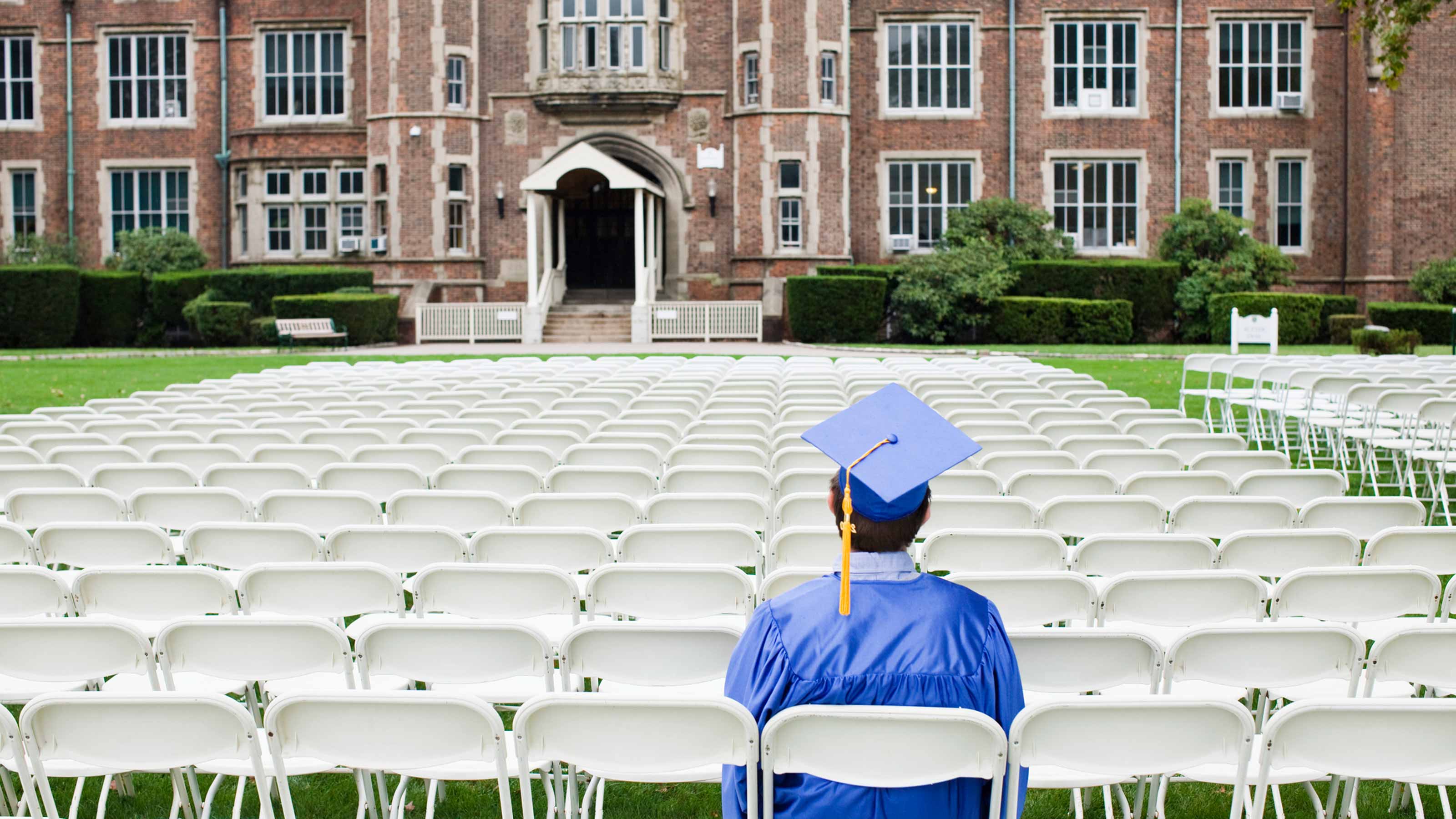
Christopher Rose was close to finishing his third year at Fontbonne University in St. Louis last March when the entire student body received a message to meet in the school’s main gymnasium. After the students gathered, the college’s president announced that Fontbonne would be closing at the end of the summer term in August 2025.
“It shook a lot of students,” says Rose. “A lot of kids were in the same position as me, with uncertainty about the future and having to scramble to find a path forward. It had been a close community, like a second home. Everybody worried about financial aid and transferring credits.”
Fontbonne made agreements with 25 colleges that offered to accept most credits and charge students no more than they were paying at Fontbonne. But the disruption of having to change schools and possibly add extra semesters hit the students hard.
Several colleges came to Fontbonne’s campus in April to discuss their programs and transfer process. After meeting with a few schools, Rose decided to switch to the University of Missouri–St. Louis starting in fall 2024. Because the university didn’t offer a marketing major, he had to change his major from marketing to business administration with a concentration in marketing and add an extra year to his studies.
Even though he liked the close-knit community of a small school, Rose chose to finish up at a large public university because he worried about the stability of some of the small schools. “With the financial uncertainty, it was the safest bet for me,” he says.
Colleges throughout the country are struggling financially as enrollment shrinks and expenses rise. Nearly 100 higher-education institutions closed between the 2022–23 and the 2023–24 academic years, according to the Department of Education’s National Center for Education Statistics. Many were for-profit programs or two-year colleges that merged into other programs. But some were traditional four-year colleges with long histories.
Fontbonne University, for example, recently celebrated its 100th anniversary. Founded by the Sisters of St. Joseph of Carondelet in 1923 as a women’s liberal arts college primarily to educate teachers, the school became well known for its deaf-education program. It went co-ed in the 1970s and expanded to 44 under-graduate majors and 19 graduate majors. But enrollment dropped significantly over the past decade — from 1,781 students in fall 2014 to 874 students in fall 2023 — and the school couldn’t keep up financially.
“It became clear to the leadership team that it was too risky to try to continue the institution,” says Adam Weyhaupt, Fontbonne’s executive vice president and provost. “It seemed like the most responsible thing to do was to wind down the institution in an orderly, dignified way.”

Fontbonne didn’t have a large endowment (something it had in common with many colleges). With a significant number of its graduates focusing on careers known for service rather than salaries, such as special education and social work, large gifts from alumni were rare.
The school also took pride in its mission to provide opportunities to students in need: 56% of Fontbonne’s current students are eligible for Pell Grants, and one-third are first-generation college students, like Rose. “We can’t just increase tuition,” says Weyhaupt.
The majority of small private colleges rely primarily on tuition and fees to remain afloat, and those numbers aren’t looking good. A drop-off in births after the 2008 recession, combined with a decline in the percent-age of high school graduates going directly to college after the COVID pandemic, has left a smaller pool of potential students to go around.
“We’re entering a period when fewer students are going to college — there are fewer 18-year-olds — and this was predictable years ago,” says Dick Startz, distinguished professor of economics at the University of California, Santa Barbara, who wrote a paper for the Brookings Institution in October 2024 about the college-enrollment cliff.
“There’s been lots of expansion in colleges, and for a long time the number of students going to college was going up. But that’s leveled off and come down some, and that’s going to be a problem for colleges that are weaker financially.”
The headlines about colleges with record numbers of applications and minuscule acceptance rates apply only to a very small percentage of schools, says Sara Harberson, a former dean of admissions and founder of Application Nation, which helps families navigate the college admission process. “Ivy League universities, elite colleges with large endowments, and nation-ally known institutions dominate the news stories. But most colleges are experiencing the effects of a declining enrollment and a shrinking pool of high school graduates.”
Some of these troubled schools were temporarily bolstered by federal COVID relief funds, but closures have increased as those funds have dried up. “There were few closures during the pandemic because of all the pandemic relief funds, but we’re seeing a few more closures now than before the pandemic,” says Robert Kelchen, professor and head of the department of educational leadership and policy studies at the University of Tennessee, Knoxville. “Enrollment as a whole is down, and operating costs are up.”
Because of the demographic trends, with fewer young people applying to college, it’s going to get even worse, says Robert Massa, vice president emeritus for enrollment at Dickinson College, who spent more than 50 years in the enrollment and business side of college administration.
How to assess a college's financial stability
If you’re looking at college for your child or yourself, it’s important to check out schools’ financial situation as you narrow down your list.
“Most families do not consider a college’s financial stability until after the student has been admitted and is deciding where to enroll,” Harberson says. By then, she says, the student may have become attached to the college, making it difficult to change course.
Even if a struggling college doesn’t shut down, your child’s education could suffer — and you may need to pay for additional semesters — if professors are laid off or departments are eliminated. A financially stressed school also may also cut back on student support programs, such as academic advising and the student health center, and may neglect its buildings’ upkeep.
Here are some steps to take to research a college’s financial situation and questions to ask if you find red flags:
Look at enrollment trends. One of the early warning signs that a college is in trouble is a shrinking freshman class, says Emily Wadhwani, senior director and the sector lead for the higher education team at Fitch, the ratings agency. “That will translate into lower enrollment as that smaller class cycles through, and it can become unmanageable if that persists.”
Tuition and fees account for more than 70% of revenue at most schools, and more than 90% at some, Wadhwani says. “Those schools are extremely vulnerable to changes in enrollment.”
Massa recommends reviewing enrollment numbers in the Common Data Set, an easy-to-read resource most colleges provide for college rankings research. “My advice to parents is to go to a college’s website and type ‘common data set’ in the search bar,” he says. “Go back five to seven years and look at the enrollment section of the report.” Compare the numbers for freshman enrollment, number of applicants and the percentage that were accepted to the most recent figures.
“If you see a big drop-off in applications and an increase in acceptance rate, that will impact applications in the future because the less selective you are, the less students want to go there,” he says. “If there’s a big drop-off in freshman enrollment, that’s a red flag.”
You can also find statistics using the Department of Education’s College Scorecard and the comprehensive but less user-friendly Integrated Postsecondary Education Data System.

Search for news stories about the college’s finances. “Google the college and see what articles come up,” says Massa. “If there are financial issues, it’s going to show up in the press, whether it’s the regional press or the higher-ed press.” You may find reports of faculty layoffs, departments closing, debt problems or attempts by the college to redirect endowment funds.
“For most of the schools that close, it’s not actually a big surprise,” says Startz. “There are often news stories about the school cutting back and having financial difficulties.” He also recommends checking the school’s student-run paper.
Review college finance watch lists. The Scholarship Foundation of St. Louis has been analyzing colleges’ finances since 2019 and keeps a watch list of colleges with special financial concerns. The November 2024 list includes 35 schools.
“We understood the impact of students attending under-resourced schools,” says Faith Sandler, the program’s executive director. “We felt that we owed it to our students to help them broaden the information that they had before making a decision.” Chris Rose is a scholarship recipient and senior fellow with the Scholarship Foundation, and he reviewed its list when deciding where to transfer.
The Department of Education lists schools it has concerns about in its Heightened Cash Monitoring list. The criteria include student-aid compliance issues as well as a college’s finances. If a school you’re interested in is on the list, it’s worthwhile to ask questions. If a school is on probation with its accreditor or on the HCM list, you should ask representatives what led to the situation and what plans they have to improve, Kelchen says.
Look up bond ratings. When a college issues bonds to help fund large capital projects, bond rating agencies assess the college’s financial strength.
“By and large, the colleges that close have been unrated or have had ratings at the low-triple-B or high-double-B level or below,” says Wadhwani of Fitch Ratings. “Our median rating for institutions is in the A category.” At Fitch, you can find ratings by typing in the name of the school.
You can also research colleges at Standard and Poor’s and Moody’s, two of the largest bond rating agencies. At Moody’s, you need to register, but it’s free. For Standard and Poor’s, you’ll also need to sign up for free registration. Once you’ve registered, search for reports on not-for-profit colleges; these reports list ratings for various schools.
Notice the condition of the campus. A Pennsylvania woman whose daughter went to a small liberal arts college in the Northeast says she sensed the college was in trouble when she noticed that its landscaping and overall campus condition were visibly in disrepair (she asked that her name not be used). Then, the bathroom ceiling in her daughter’s dorm caved in. Soon after, the college cut several majors, laid off faculty and sold off campus buildings to reduce its debt. Her daughter transferred to another school.
“Take a look at the housing and academic buildings as you tour the campus,” she recommends.
Ask questions of the college’s business office. If you find any red flags in your research, Massa recommends asking the admissions office whether you can speak to someone in the business office about the school’s financial situation.
“Talk to the finance people and get a candid appraisal,” he says. If the school gives you the runaround, that can be a sign of trouble.
Investigate the stability of the major you’re considering. A much more common problem than colleges closing is schools eliminating departments and majors. That has been an issue at both public and private colleges, says Startz.
“Even if a student wants to pursue something entirely different, their educational journey will be impacted as more students are forced into other majors and programs. This can lead to a longer under-graduate experience — and a more costly one,” says Harberson.
Sandler recommends talking with faculty in the department you’re considering to find out more about the program’s stability and size.
Note: This item first appeared in Kiplinger Personal Finance Magazine, a monthly, trustworthy source of advice and guidance. Subscribe to help you make more money and keep more of the money you make here.







